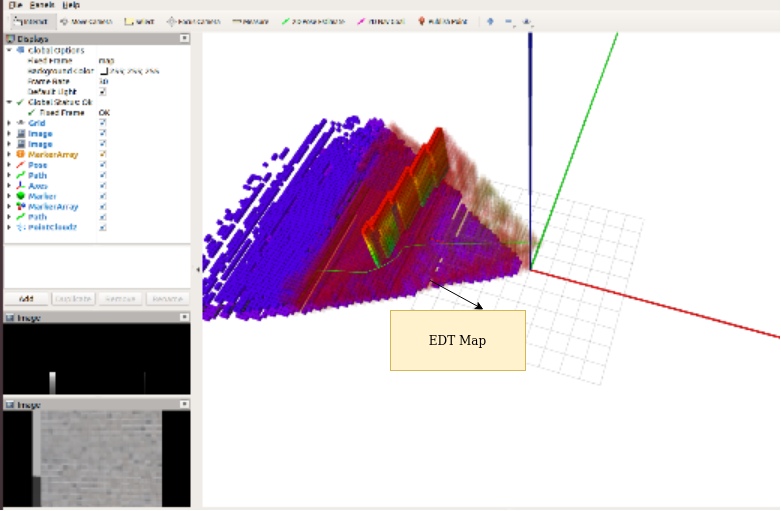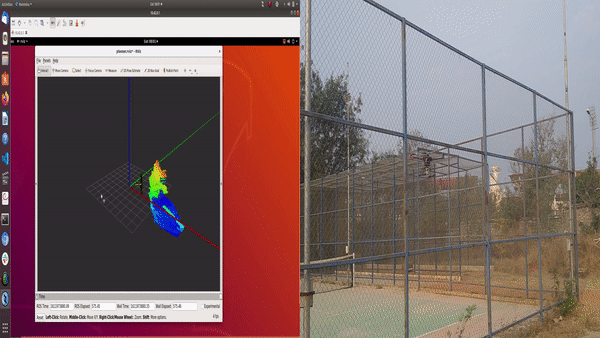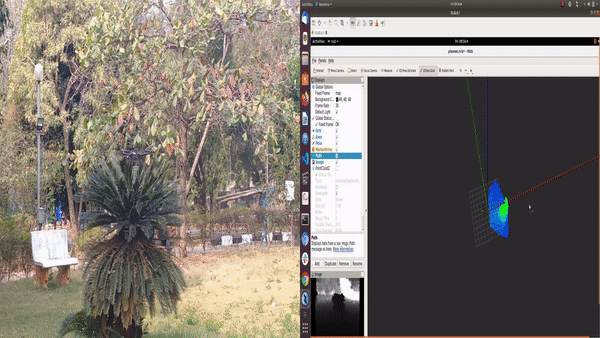Obstacle avoidance for drones using FastPlanner (https://github.com/HKUST-Aerial-Robotics/Fast-Planner), PX4 and Octomap.
-
Mapping has been done using Octomap
-
Fixed size euclidean distance map is computed using EDT3D Library (https://github.com/OctoMap/octomap/tree/devel/dynamicEDT3D) for collision check.
-
Fixed Size EDT map gets updated around the drone after it travels a threshold distance from the previous location at which map was updated (here threshold is 1 metres).
-
Point cloud from the RGBD sensor (RealSense D415 and D455 were tested) is downsampled using pcl_ros
-
Zero mean Gaussian noise is added on the point cloud using pcl library
-
Installing mapping dependencies
sudo apt-get install ros-$DISTRO-octomap-* sudo apt-get install ros-$DISTRO-pcl-ros git clone https://github.com/OctoMap/octomap (Octomap source code is needed to generate EDT map (DynamicEDT3D class)) cd octomap mkdir build cd build cmake .. && make sudo make install
- Path planning is done using Fast-Planner (https://github.com/HKUST-Aerial-Robotics/Fast-Planner) developed by HKUST Aerial Robotics Group.
- Currently only the kino-dynamic A* star algorithm has been implemented (implementation of the Bspline optimization with octomap is going on currently)
- Changes have been made in the source code in order to use it with Octomap.
- Goal location is currently given in cartesian coordinates (using RViZ 2D Nav Goal and height of the goal is taken from the user)
-
PX4-Autopilot firmware has been used to control the drone (https://github.com/PX4/PX4-Autopilot).
-
Trajectory generated by the planner is traversed using offboard position control.
-
Position messages (with and without yaw) is published on the topic /mavros/setpoint_local/position.
-
Mavros has been used to pass the waypoints to the Pixhawk flight controller.
-
Installing PX4-Autopilot
Refer to https://github.com/PX4/PX4-Autopilot for setting up PX4 for simulation -
Installing Mavros
sudo apt-get install ros-$DISTRO-mavros ros-$DISTRO-mavros-extras wget https://raw.githubusercontent.com/mavlink/mavros/master/mavros/scripts/install_geographiclib_datasets.sh sudo bash ./install_geographiclib_datasets.sh
- GPS is used for localizing the drone
- Poses given by the EKF in PX4 is used (/mavros/local_position/pose)
-
Building package
sudo apt-get install libeigen3-dev mkdir catkin_ws cd catkin_ws mkdir src cd src git clone https://github.com/deepak-1530/FastPlannerOctomap cd .. catkin_make
-
Simulation
Terminal-1 : cd PX4-Autopilot && sudo no_sim=1 make px4_sitl_gazebo Terminal-2 : cd PX4-Autpilot && source Tools/setup_gazebo.bash $(pwd) $(pwd)/build/px4_sitl_default && roslaunch gazebo_ros empty_world.launch (set your world file as required). On the gazebo window, select iris_depth_camera from the left panel. Terminal-3 : rosrun FastPlannerOctomap pcNoise (then enter the variance value) Terminal-4 : cd catkin_ws && **roslaunch FastPlannerOctomap MappingSim.launch** (give goal location using 2D Nav Goal option) Terminal-5 : **rosrun FastPlannerOctomap Planner** (or noYawPlanner if you want to plan the trajectory keeping the heading or yaw of the drone fixed). For the startOver option select either 1 or 0. Refer to the source code (FastPlannerOctomap/src/kinodynamic_astar.cpp and Planner.cpp for details). Also give the height (in metres) of the goal location when prompted. Terminal-6 : **rosrun FastPlannerOctomap Controller** -
Running on hardware
Terminal-1 : Launch the depth camera (I used realsense_ros package and rs_camera.launch file) Terminal-2 : roslaunch mavros px4.launch Terminal-3 : roslaunch FastPlannerOctomap MappingDrone.launch Running the planner and controller remain the same as in simulation. Remote Desktop is used to run rviz and give the goal location.


